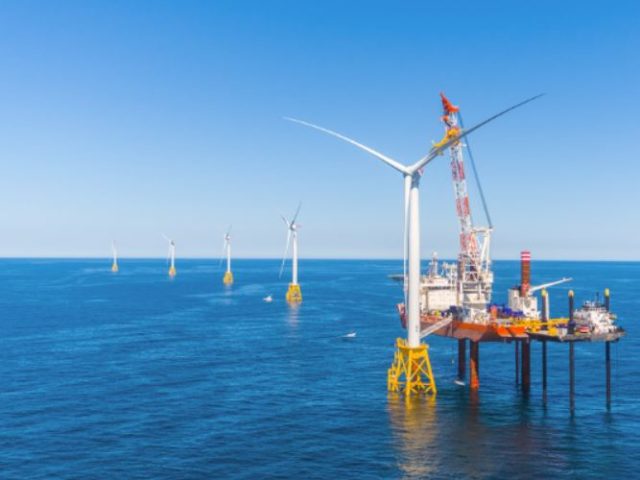Offshore Wind Power: Finally Made in the USA
 This month, construction was completed on the nation’s first offshore wind farm, a 30 MW, five-turbine project located three miles off the Block Island shore. The turbines will replace the island’s diesel generators and provide electricity to the Rhode Island grid – enough to power about 17,000 homes. It is supposed to go online later this fall.
This month, construction was completed on the nation’s first offshore wind farm, a 30 MW, five-turbine project located three miles off the Block Island shore. The turbines will replace the island’s diesel generators and provide electricity to the Rhode Island grid – enough to power about 17,000 homes. It is supposed to go online later this fall.
It’s not a big project, by global standards, but it’s a beginning; and it may prove to be the proverbial pebble that starts an avalanche. The federal government has awarded a dozen offshore leases in states from Virginia to Massachusetts, and according to the LBNL 2015 Wind Technologies Market Report, there are 22 additional offshore wind farms now in development, many in the Northeast, and many larger than the Block Island project.
Cognizant of the technical, economic and political barriers facing offshore wind developers, Atlantic coastal states are increasingly stepping up their support of the nascent industry.
Massachusetts is one of the states that seems poised to follow Rhode Island’s lead. This month, the governor signed into law a bill requiring utilities to buy a combined 1,600 megawatts of offshore wind power by 2027 – the first law of its kind in the nation – and MassCEC has announced grants amounting to $700,000 for nine academic and research institutions across the state to identify industry workforce training and safety requirements, establish a multi-university partnership to spur innovation and reduce costs, and develop a new technique to monitor the structural health of wind turbine blades. In addition, the New Bedford, MA Maritime Terminal, a state-funded port specifically designed to support the offshore wind industry, is beginning to see business, in the form of the Denmark-based research vessel Ocean Researcher, which docked there en route to Martha’s Vineyard, where it will study the geophysics of the ocean floor.
New York is also making strides. The state’s Public Service Commission has approved a new Clean Energy Standard requiring 50% clean energy by 2030, and NYSERDA is working on a blueprint to advance offshore wind energy as part of plans to meet that goal. NYSERDA has also announced its intent to bid into a federal leasing process for New York’s Wind Energy Area. And Deepwater Wind, the company that constructed the Block Island project, is proposing a 90 MW, 15-turbine wind farm off the coast of Long Island.
Among the larger offshore wind projects proposed for the Northeast is US Wind’s 500 MW project, which has conducted site survey work off the coast of Ocean City, Maryland. That state has extended its open application period for offshore wind projects, which was supposed to close this month, until September 22. The application period is part of a process set in motion by the Maryland Offshore Energy Act of 2013, which, in addition to establishing an application and review process, created a carve-out for offshore wind energy in Maryland’s RPS, specified maximum price and projected rate impacts for electric customers, established a Maryland Offshore Wind Business Development Fund and Advisory Committee within the Maryland Energy Administration, and created an escrow account to ensure the transparent transfer of Offshore Renewable Energy Credits between offshore wind generators and electric suppliers.
Offshore wind, like any other generation technology, will need to demonstrate its value in order to overcome opposition. In the Northeastern US, it appears to be on the cusp of achieving such a demonstration.
***
The Offshore Wind Accelerator Project (OWAP), a joint effort of Clean Energy Group and the Clean Energy States Alliance (CESA), supports states’ efforts to roll out offshore wind energy in the US. Among other activities, OWAP administers the Northeast Wind Resource Center (NWRC), which manages the Offshore Wind Hub and produces a monthly newsletter.
This blog post was also published in Renewable Energy World.
Published On
August 31, 2016

